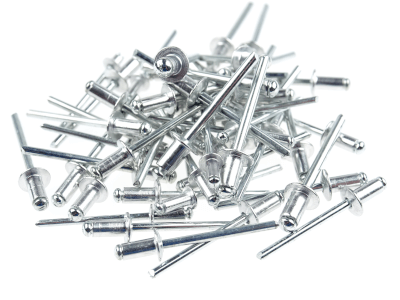What Is a Rivet?

Rivets are used for joining materials together.
They are easy to install, provide a strong joint, and maintain their grip even under vibration, offering consistent tightness comparable to bolt-nut connections. Rivets, however, are permanent fixtures that can only be removed by drilling them out.
Rivets have a slender rod-like body with a head, and when driven, the excess part of the rod is trimmed automatically. Rivets can be applied from one side, making them suitable for use in hard-to-reach places.
Uses of Rivets
Rivets are versatile, used in applications ranging from the construction of ships and aircraft to everyday items like cookware. They are also used to join metal plates and meshes in industrial machinery.
In building construction, rivets provide secure joints for large beams and facades, ensuring stability without compromising the building’s appearance.
Features of Rivets
Understanding the advantages and limitations of riveting is crucial for selecting the most appropriate joining method for your needs.
Pros
Riveting is straightforward, making it accessible to beginners with proper guidance. The connection it forms is durable and resistant to loosening. Rivets ensure safety by holding firm unless the base material is compromised. They can be removed by drilling out the rivet, which focuses heat at the tip, sparing the base material from damage.
Disadvantages
Rivets, typically made from heavy metals like copper and stainless steel, can add significant weight to a product. Drilling holes in curved or tubular bases is challenging, limiting their use to flat materials. The protruding heads of rivets may be visually unappealing, making them less suitable for design-centric applications.
How to Use Rivets
To install rivets, pre-drill a hole matching the rivet’s diameter. Insert the rivet into the hole, and the riveting tool will trim the excess portion as it is driven in. The tool can be reset for the next rivet by removing the trimmed part.
Riveting works by pulling a ball attached to the rivet’s tip upwards, deforming the rivet. This deformation secures the rivet in place by clamping the material between two plates, one in front and one behind the material.
Riveting tools include manual hand riveters, electric riveters, and pneumatic riveters, with the latter two options significantly reducing labor and time for large-scale applications.
Types of Rivets
There are mainly three types of rivets: blind rivets, hollow rivets, and resin rivets.
1. Blind Rivets
Blind rivets are widely used because they can be installed from one side. The fastening pressure is lower compared to solid rivets of the same diameter. They are user-friendly, even for beginners, offering a strong fastening solution with a broad range of sizes and standards, making them ideal for DIY projects.
2. Hollow Rivets
Hollow rivets have a lightweight, hollow shaft. Although requiring special tools for installation, they are used in diverse applications, from school bag parts to office supplies. They allow for the selection of an appropriate shape and standard for specific needs.
3. Resin Rivets
Made from soft resin, these rivets are utilized for joining plastic components in vehicles and motorcycles. They are easy to dispose of without the need for separation and can be installed without special tools, making them convenient for DIY projects and beginners.